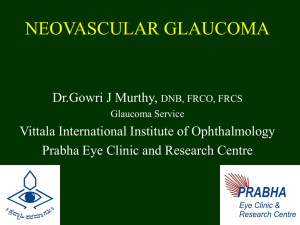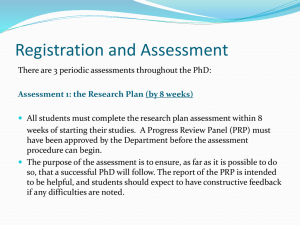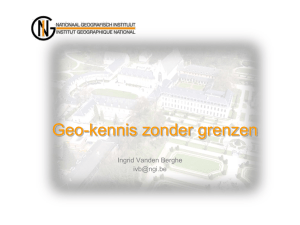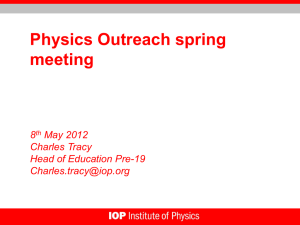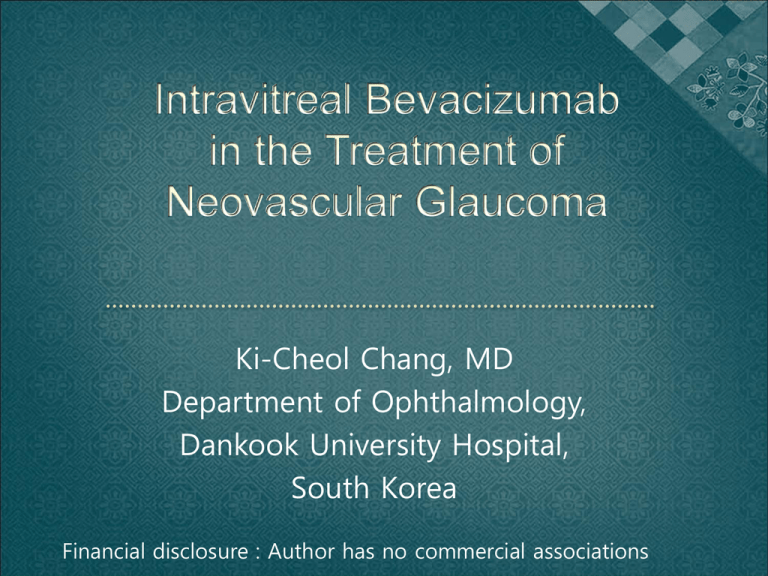
Ki-Cheol Chang, MD
Department of Ophthalmology,
Dankook University Hospital,
South Korea
Financial disclosure : Author has no commercial associations
Retinal Ischemia (Diabetic retinopathy, CRVO, OIS, etc)
VEGF, BFGF, IGF-I, EGF
Ocular Neovascularization
Iris Neovascularization (INV), PAS, Angle closure
Neovascular Glaucoma (NVG)
For Retinal ischemia
Panretinal photocoagulation (PRP)
Anti-VEGF ?
For IOP control Ocular anti-hypertensive medications
Glaucoma drainage surgeries
Cyclodestructive procedures
To evaluate the usefulness of Intravitreal
Bevacizumab* (IVB) for treatment of NVG
caused by ischemic retinal disease
* Bevacizumab (Avastin®, Genentech Inc, South San Francisco, CA)
1. Full-sized recombinant antibody that binds all isoforms of VEGF
2. Half-life : up to 20 days
3. Approved by FDA as antiangiogenic agent for the treatment of
metastatic colon cancer
4. Off-lebel ophthalmic uses of IVB - PDR, CME, ARMD with CNVM,
INV and NVG, etc.
Ophthalmic evaluations : History, V/A, IOP, Slit-lamp
biomicroscopy, Gonioscopy, Fundus exam (including FAG if
possible)
2.5 mg/0.1 mL Intravitreal bevacizumab (Avastin® ) with
paracentesis
For reduction of retinal ischemia, 1 week later, PRP if
possible (even if PRP had been done)
Despite of IVB and maximal tolerable medical
treatment(MTMT), IOP > 25mmHg
surgical management was considered if possible
During follow-up, If INV recur additional PRP with or
without IVB
Participants : 12 patients were included with NVG d/t
ischemic retinal disorders (2007.2 – 2008.10)
All Pre-IVB IOPs couldn’t be controlled despites of
MTMT
All patients showed complete or significant INV
regression at 1 week after IVB
Open-angle stage (PAS<90) NVG IOP could be
controlled without surgical management
Angle closure stage (PAS>270) NVG For IOP
control, additional glaucoma surgery were needed.
No eye taken subsequent Ahmed implantation
showed intra - and post - operative bleeding
Only one eye showed hyphema during paracentesis
directly after IVB
Patients characteristics
PAS
Initial
VA
Pre-IVB
IOP
(mmHg)
After
MTMT
IOP
1wk aft
er IVB
(mmHg)
Additional
PRP
Surgical
treatment
No. of
anti-gla
ucoma
Agent
IOP 1Mo
after IVB
(mmHg)
IOP 3 M
o after I
VB
(mmHg)
No
Dx
Age
/
Sex
F/U
(mos)
IOP at
last visit
(mmHg)
VA at
last visit
1
PDR
70/
M
>
270
LP(+)
40
32
O
Ahmed
0
8
13
3
13
HM
2
PDR
43/
M
<90
0.2
42
12
O
None
2
12
9
4
10
0.6
3
CRVO
72/
M
360
LP(+)
34
34
X
Ahmed
0
9
10
5
14
LP(+)
4
CRVO
70/
F
360
FC
30cm
31
37
O
Ahmed
0
11
10
(re-PRP)
5
14
HM
5
PDR
82/M
<90
0.08
38
7
O
None
2
12
13
3
13
0.15
7
PDR
63/F
< 90
HM
36
18
O
None
2
12
11
3
11
0.05
8
PDR
Trabecul
ectomy
63/M
>
270
FC
10cm
28
39.3
O
2
10
(filtration
increased)
13
4
12
0.08
9
Unkown
d/t VH
72/M
>
270
HM
34
27
X
2
20
36
(re-PRP
+ IVB)
7
16
LP(+)
10
CRVO
53/M
<90
FC30c
m
36
10
O
None
2
12
14
5
13
FC20cm
11
PDR
41/
M
360
0.02
55
48
O
Ahmed
1
12
13
4
12
0.05
12
OIS
66/
M
>
270
HM
38
34
O
Ahmed,
Stent at
ICA
1
21
16
3
16
HM
None *
(Pt
rejected)
None *
(Pt
rejected)
Figure 1. Case 2 (43/M, PDR)
(upper row) pre-IVB (IOP=42, PAS < 90) A. Iris neovascularization (INV)
was detected at papillary margin. B,C. NV and focal PAS were detected
at anterior chamber angle.
(lower row) 1 week after IVB (IOP=12) D,E,F. NV at pupillary margin
and anterior chamber angle resolved completely.
Figure 2. Case 4 (70/F
, CRVO)
A. Pre-IVB (IOP=31, 36
0º PAS), Severe INV
was detected.
B. 1week after IVB,
INV decreased signi
ficantly, however, IO
P was 37 mmHg
C. 4 week after IVB,
only ghost INV
was detected.
D. 4 months after IVB,
INV recurred and
then additional PRP
was done.
Figure 3. Case 3 (72/M, CRVO). Due to mature cataract and corneal opa
city, PRP was not available. 1 week after IVB, Ahmed valve implantation
was done without intraoperative bleeding.
A,B. pre-IVB(IOP=34).
C. 5 months after IVB, there was no recurrence of INV.
Our study showed that IVB might be a safe and effective
adjunct in NVG as previous reports showed.
Advantages of IVB in NVG
A. Rapid resolution of anterior segment
neovascularization
1. More effective IOP control
2. Improving postoperative results by reducing
inflammation and bleeding
B. Can be a (temporary ?) substitute of PRP when PRP is
impossible d/t media opacity such as mature cataract,
vitreous hemorrhage and corneal opacity
However, Adequate PRP is essential
A. INV and NVG occurred despite of previous PRP
B. The effect of IVB is transient
(3 months or more ?)
C. Inadequate PRP or persistent retinal ischemia
Recurrence of ocular neovascularization
Complete regression of INV
A. main indicator of adequate PRP
B. However, it can also be induced by IVB with
inadequate PRP
Be careful not to ignore the importance of
adequate PRP
NVG with closed angle usually needed subsequent
glaucoma surgeries despite complete INV regression
after IVB and PRP
Intra-cameral vs. Intra-vitreal
Intravitreal IVB
1. may be more effective for combined retinal
neovascularization or macular edema
2. lower risk of hyphema during injection
3. higher risk of posterior segment complication
including endophthalmitis



